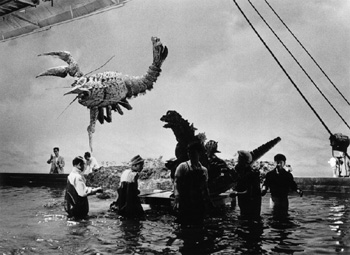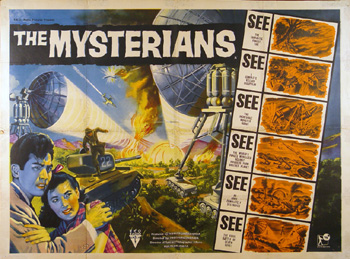Author: Richard Pusateri Source: Chronicle Books Special thanks to Brad Warner and Ed Godziszewski
North American fans of Japanese science fiction, horror and fantasy movies received a wonderful gift in late 2007. The first English language book detailing the life and work of Eiji Tsuburaya has arrived. Eiji Tsuburaya: Master of Monsters, produced with the cooperation of Tsuburaya Productions and Toho Company Ltd., has photographs from the best sources and text by August Ragone, perhaps the most knowledgeable American on the subject of Japanese fantasy movies and television. Brad Warner, of Tsuburaya Productions Los Angeles office, is the “hidden hand” that shaped, edited and guided this book to completion. Other contributors are John Paul Cassidy, Norman England, Ed Godziszewski, Mark Nagata, Shogo Tomiyama, Akira Tsuburaya and the late Guy Mariner Tucker. Eiji Tsuburaya: Master of Monsters is the first notable addition to English language library specifically about the career of Eiji Tsuburaya, the unchallenged master of “tokusatsu” or Japanese special effects films. By now, anyone who is interested in science fiction from Japan (and reading this essay at a web site called SciFi Japan) probably already has this book. It is a hefty volume, with striking designs over the cover, spine, back cover and even the exposed side of the pages. The first thing to strike the eye inside is the large collection of delightful photographs (most permission wrangled by Warner) with an emphasis on behind-the-scenes production stills from the collections of Ed Godziszewski, Bob Johnson, the author August Ragone, Akinori Takagi, Toho Co. Ltd. and Tsuburaya Productions. By any measure, this is the definitive documentation of the production of Japanese science fiction movies published in North America. We can relish behind-the-scenes photos of monster suit and miniature set construction, candid snapshots of Mr. Tsuburaya at work and relaxing. The photographs of Mr. Tsuburaya and his technical team standing on the vast miniature sets indicate the scope of the efforts. I especially like the photos that include cameras being set up as technicians prepare the suit actors. Other artwork includes almost every type including many examples of design sketches, storyboards, lobby cards, international posters, and even advertising tie-in campaigns. This book has a long history, beginning more than 20 years ago with Ragone writing a lengthy, detailed manuscript about the history of Tsuburaya Productions with an emphasis on Ultraman series of television programs. A few years ago, Warner approached Chronicle Books with an offer to produce a book on the life and work of Eiji Tsuburaya and he went to work convincing his employers at Tsuburaya Productions to authorize the project. The Year 2001 Eiji Tsuburaya 100th Birthday Commemoration Project led to a number of projects that included the cooperation of the Toho Co. Ltd. Eventually, Warner was able to secure the authority of Tsuburaya Productions through the “good offices” of the Eiji Project.
 The book features a wealth of behind-the-scenes and promotional pictures, including dozens of photos from the collection of Ed Godziszewski. GODZILLA VS THE SEA MONSTER © 1966 Toho Co., Ltd.
The book features a wealth of behind-the-scenes and promotional pictures, including dozens of photos from the collection of Ed Godziszewski. GODZILLA VS THE SEA MONSTER © 1966 Toho Co., Ltd.When Ragone came aboard the project in 2005, he brought the authority of his credentials. Over the decades, Ragone has written extensively on Japanese fantasy movies and television especially Toho and Tsuburaya productions. His incomparable knowledge of the genre and writing in magazines and on the Internet were researched during extended periods of residency in Japan, evolved from an overview of the Ultra-universe into the examination of the life and work of Eiji Tsuburaya that we now have to enjoy. The text is more of a career retrospective than a true biography. Details of Mr. Tsuburaya’s life outside the special effects stage take up a small part of the 208 pages. Rather than revealing details of Mr. Tsuburaya’s influences or details of his work techniques, Ragone really has given us an overview of his life’s work instead of his life. After about ten pages of Mr. Tsuburaya’s life and early career, we plunge into the groundbreaking achievements of the original GODZILLA in 1954. After that, the book describes the movies he worked and later an emphasis on the television work of his own company Tsuburaya Productions. All the way through, we are reminded of Mr. Tsuburaya’s personal creativity, high standards of quality, work ethic, consideration of the children in his audience, but many details of his work’s innovative techniques are omitted. I would have liked to read more about the high-speed camera work that required special lighting with film stock available during early years. I would have liked to read more about the editing process; both of the special effects footage and how that was cut into the live action. While Ragone generously tells us about the mechanical special effects especially miniature photography, I would have like to read more about the in-camera optical effects (without the benefit of pin registration cameras), and matte photography of the early days, before the advent of the optical printer. That kind of information might be eyeball-glazing to the general readership, so Ragone has probably done most readers a favor by omitting the technical specifications data. Reportedly, Chronicle Books did not want this to be a (dry?) academic volume. At least the inclusion of a photo of the legendary Oxberry 1200 optical printer is a special treat for a gearhead like me.
 British quad poster for THE MYSTERIANS, crediting the fx direction of Eiji Tsuburaya. Photo courtesy of Ed Godziszewski. © 1957 Toho Co., Ltd.
British quad poster for THE MYSTERIANS, crediting the fx direction of Eiji Tsuburaya. Photo courtesy of Ed Godziszewski. © 1957 Toho Co., Ltd.Even though Chronicle Books wanted an easy-to-read book, the omission of most attribution, footnotes, chapter notes or even a bibliography, leave much information to be desired. Two passages especially required some kind of attribution. The oft-told tale, repeated on page 28 “After the war, American occupation forces mistook Tsuburaya’s surprisingly realistic footage for the genuine article…” is repeated here with no attribution or qualifier that it might be apocryphal. Almost certainly, no members of the U.S. Army Air Force Air Technical Services (the unit that scoured post-war Japan for any experimental aircraft, blueprints or other aviation documentation including gun camera footage) would be fooled for more than a moment by Tsuburaya’s special effects footage in a dramatized popular film account of the historical event. Additionally, the assertion on page 30, “Occupation officers believed that… Tsuburaya must have been part of an espionage ring.” is so sensational that it needs attribution to be taken seriously at all. With the exception of those oversights and a few other minor, inconsequential “gaffes,” Ragone’s knowledge, and labors are manifest in this wonderful book. Ragone’s passion for the universe of Japanese science fiction, horror and fantasy movies and television make Master of Monsters a joy to read. In one paragraph on page 94, Ragone neatly captures the key to understanding how Mr. Tsuburaya’s approach made his work so enjoyable. Ragone quotes Koichi Takano relating why Mr. Tsuburaya used an obvious toy horse instead of optically compositing a real one in FRANKENSTEIN VS BARAGON (FRANKENSTEIN CONQUERS THE WORLD in the U.S.). Mr. Tsuburaya’s reply “Using a model horse was more fun.” illustrates perfectly why Japanese special effects films are dedicated to creating a clear, sublimely produced artifice of eye-pleasing “beauty” rather than simply an illusion recreating reality. Eiji Tsuburaya: Master of Monsters Hardcover 208 pages Published in October, 2007 ISBN 0811860787 ISBN13 9780811860789 SRP: $40.00


 Eiji Tsuburaya: Master of Monsters. © 2007 Tsuburaya Productions/ Chronicle Books LLC"/>
Eiji Tsuburaya: Master of Monsters. © 2007 Tsuburaya Productions/ Chronicle Books LLC"/>